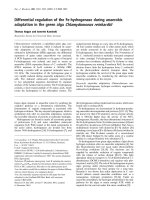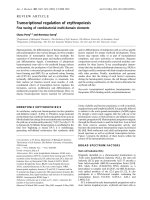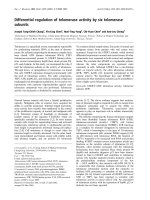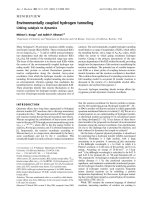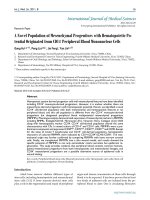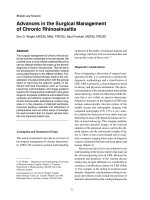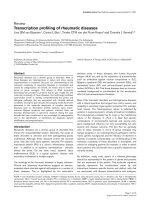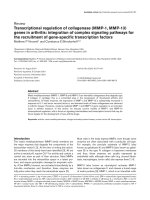Báo cáo y học: "Transcription regulation: no holy grail, but many treasures" pot
Bạn đang xem bản rút gọn của tài liệu. Xem và tải ngay bản đầy đủ của tài liệu tại đây (59.39 KB, 3 trang )
Genome Biology 2005, 6:334
comment
reviews
reports
deposited research
interactions
information
refereed research
Meeting report
Transcription regulation: no holy grail, but many treasures
Nicola A Hawkes and Patrick Varga-Weisz
Address: Babraham Institute, Babraham, Cambridge CB3 4AT, UK.
Correspondence: Patrick Varga-Weisz. E-mail:
Published: 29 June 2005
Genome Biology 2005, 6:334 (doi:10.1186/gb-2005-6-7-334)
The electronic version of this article is the complete one and can be
found online at />© 2005 BioMed Central Ltd
A report of the Biochemical Society Annual Symposium
‘Transcription UK’, London, UK, 13-15 April 2005.
How does a transcription factor bring about gene regula-
tion? This key question has been tackled for decades, but
there is no unifying answer. Some researchers emphasize
recruitment mechanisms by which activators target the basal
machinery, in effect RNA polymerase, to the promoter; and
some put the emphasis on regulation through alterations in
chromatin structure and histone modifications. A recent
meeting on transcription in London provided an opportunity
to learn about progress in this field.
Focus on RNA polymerase
In a meeting on transcription, a surprising statement by
Peter Cook (University of Oxford, UK) was that transcription
does not happen very often. But this is what his analysis of
transcript abundance in Escherichia coli and yeast suggests.
Even when RNA polymerase has been recruited to a pro-
moter, only a small minority of the transcripts initiated will
make it to full-length RNA, as the processes of initiation,
elongation and termination are subject to multiple levels of
regulation, as described in several other talks at the meeting.
The take-home message given by Jesper Svejstrup (Cancer
Research UK, London, UK) may be just as paradoxical as
Cook’s, namely that RNA polymerase II (pol II) degradation
can be good for transcription. This is because stalled pol II
could be fatal. A DNA strand break can lead to pol II arrest,
and as RNA polymerase cannot bypass the lesion, the stalled
pol II will lead to a pile-up of polymerases with subsequent
gene shutdown that could be lethal in a haploid organism
such as yeast. Svejstrup’s lab has identified the targeted
ubiquitin-mediated degradation of stalled polymerases by
the Rad26-Def1 complex as a mechanism for dealing with
this problem and has reconstituted the reaction in vitro.
After RNA polymerase has successfully transcribed through
a gene, termination of transcription becomes an important
regulatory step that may, in turn, impact on subsequent tran-
scriptional reinitiation. Analysis of transcriptional termination
in the human β-globin gene has revealed the phenomenon of
co-transcriptional cleavage (CoTC). Cleavage within the pre-
messenger RNA, downstream of the poly(A) addition site, is
critical for efficient termination and involves an RNA self-
cleaving activity. An important question is whether this is a
general phenomenon. Alexandre Akoulitchev (University of
Oxford) described his group’s use of bioinformatics to iden-
tify a novel regulatory element, found both 5Ј and 3Ј of many
genes, which they have termed ‘Checkpoint Charlie’, and
which is believed to play a part in the regulation of CoTC and
the definition of transcription borders. Nick Proudfoot (Uni-
versity of Oxford) described his lab’s work, which has
revealed another CoTC event in the mouse albumin termina-
tor sequence. Given that Proudfoot’s work implicated ATP-
dependent nucleosome-remodeling factors in termination, it
will be interesting to see whether they regulate termination
via Checkpoint Charlie, maybe by mediating formation of a
loop between the 5Ј and 3Ј borders of genes.
When people think of transcription most think ‘pol II’,
despite the fact that transcription by RNA polymerase I (pol
I), which transcribes the rRNA genes, accounts for 50% of all
RNA synthesis within the cell. Brian McStay (University of
Dundee, UK) described how pol I transcription is dependent
on upstream binding factor (UBF) and selectivity factor 1
(SL1), the latter being essential for targeting pol I to the pro-
moter. He has found that UBF, which contains multiple
HMG boxes (motifs that are characteristic of high-mobility
group chromatin proteins and that can bend DNA), plays a
role in determining chromatin architecture, causing decon-
densation of the DNA across the ribosomal RNA gene and
also stabilizing the preinitiation complex. Joost Zomerdijk
(University of Dundee) presented in vitro transcription
experiments with a reconstituted system suggesting that
UBF also acts after preinitiation complex formation, possibly
facilitating escape of the polymerase from the promoter.
Robert White (University of Glasgow, UK) has established
that human c-Myc, which is only a weak activator of pol II-
transcribed genes, directly and markedly enhances pol I
transcription of rRNA genes, mediating recruitment of SL1
and increased histone acetylation at these loci. Together,
these findings implicate chromatin modification in the regu-
lation of pol I transcription, but also point to the critical
roles in transcriptional regulation of downstream events,
occurring after pol I or pol II loading.
Regulation of gene expression: switching on the
cofactors
The structure of the core promoter of protein-coding genes
has an important influence on basal transcription and on the
ability to respond to activators. This core comprises the DNA
sequences flanking the transcription start site, including the
TATA box, the initiator (INR) element and downstream ele-
ments, which interact with the general transcription machin-
ery to mediate the formation of the preinitiation complex.
Thomas Oelgeschläger (Marie Curie Research Institute,
Oxted, UK) presented evidence that the INR element confers
resistance to repression by the negative cofactor 2 complex,
illustrating that the transcription apparatus does not only
have to contend with repression by nucleosomes.
Michael Green (University of Massachusetts Medical School,
Worcester, USA) made a case for fluorescence resonance
transfer (FRET) for the study of protein-protein interactions
in live cells using fluorescence-tagged proteins. The method
relies on energy transfer between interacting proteins and the
majority of protein functions in yeast do not seem to be
impeded by such tags. Green’s study of the paradigm locus for
gene activation in yeast, the GAL1 promoter, indicates activa-
tion by the transcription factor Gal4 through recruitment of
Tra1, a component of the histone acetyltransferase-containing
SAGA coactivator complex (Spt/Ada/Gcn5 histone acetyl-
transferase), with little evidence that the histone-modification
enzymes present in SAGA are critical for the activation of this
gene. SAGA in turn recruits the Mediator complex, followed
by the general transcription factors, to the core promoter.
Richard Reece (University of Manchester, UK) also reported
the use of FRET to investigate the regulation of the GAL genes
by Gal4. His work illustrates how the cell ‘borrows’ and modi-
fies metabolic enzymes through evolution to mold them into
transcriptional co-regulators for nutrient-regulated genetic
switches, in this case galactokinase. The transcriptional
inducer Gal3 shares a high degree of sequence homology with
galactokinase, Gal1, but does not itself possess galactokinase
activity. The work also provided insights into how transcrip-
tion factor activity is modulated by co-regulators.
The latter theme was expanded by Andy Sharrocks (Univer-
sity of Manchester), who described how the transcription
factor Elk-1 is phosphorylated within its transactivation
domain by mitogen-activated protein kinases. This phospho-
rylation is an activating event, but he has also found that
modification of Elk-1 by attachment of the small protein
SUMO inhibits gene activation by mediating the recruitment
of histone deacetylase 2, leading to decreased histone acety-
lation at Elk-1 target genes. Surprisingly, Sharrocks has also
found that PIASx (protein inhibitor of activated STAT),
which belongs to a group of proteins thought to be involved
in attaching SUMO, is implicated in counteracting histone
deacetylase recruitment and therefore acts to activate tran-
scription by Elk-1.
Neil Perkins (University of Dundee) revealed a switching
mechanism from an oncogenic function of the transcription
regulator NFκB to that of a tumor suppressor in response to
p53, ADP-ribosylation factor (ARF) and cytotoxic stimuli. In
the absence of ARF, NFκB activates the transcription of
several oncogenes. In the presence of ARF, however, NFκB
associates with histone deacetylase 1, resulting in repression
of transcription. In summary, the analysis of co-regulators
described at the meeting puts the spotlight on chromatin-
modifying enzymes as key regulators.
Control through chromatin?
A mammalian ortholog of the SAGA complex of yeast is the
TBP-free TAF complex (TFTC). Laszlo Tora (Institute of
Genetics and Cell and Molecular Biology (IGBMC), Stras-
bourg, France) has been investigating the role of the TFTC in
the inherited neurodegenerative disease spinocerebellar
ataxia type 7. Polyglutamine expansion of ataxin-7 (ATX7), a
TFTC subunit, has been linked to this disease, and Tora
described a mouse model expressing mutant ATX7 contain-
ing a stretch of 90 glutamines in the retina. The TFTC
complex also contains a histone acetyltransferase (HAT) and
although the mutant ATX7 gets incorporated into the TFTC
and does not seem to alter the in vitro HAT activity, the
mutation leads to a gross alteration of nuclear architecture,
massive chromatin decondensation and a downregulation of
retinal cell-specific genes associated with an increase in
histone H3 acetylation at promoters in vivo. Tora suggests a
model in which deregulated TFTC function results in general
histone hyperacetylation and a diversion of activators away
from retina-specific genes.
Tony Kouzarides (University of Cambridge, UK) made a case
for the analysis of histone modifiers because many are con-
nected with the cancer process. He revealed proline isomer-
ization as a new type of histone modification involved in the
repression of specific genes and has identified cross-talk
between histone methylation and proline isomerization. The
peptidyl-prolyl isomerase Frp4 of budding yeast binds
histone H3 tails and drives proline isomerization at position
334.2 Genome Biology 2005, Volume 6, Issue 7, Article 334 Hawkes and Varga-Weisz />Genome Biology 2005, 6:334
38, which is inhibited by methylation of lysine (K) 36. In
turn, Frp4 antagonizes H3 K36 methylation.
Smads are a family of intracellular signaling molecules that
act downstream of receptors for the transforming growth
factor- family of ligands. Smad complexes translocate to
the nucleus, where they are recruited to DNA by site-specific
transcription factors and participate in regulating target
genes. Caroline Hill (Cancer Research UK, London, UK)
described experiments showing that Smad proteins do not
affect gene expression in vitro unless the DNA is packaged
into chromatin, providing further support for chromatin as a
key mediator of gene regulation.
Regulation of gene expression via chromatin-modifying
enzymes acquires a sinister side when these enzymes are
subverted as a result of chromosomal translocations in
acute myeloid leukemias. In one translocation, for example,
the histone acetyltransferase MOZ (monocytic leukemia
zinc finger protein) is fused to the histone acetyltransferase
CBP. David Heery (University of Nottingham, UK) revealed
that another translocation product, the fusion of a part of
the nuclear receptor co-activator TIF2 with MOZ (MOZ-
TIF2) results in gene misregulation through its impact on
CBP activity. MOZ-TIF2 interacts directly with CBP, leading
to aberrant cellular localization and depletion of CBP and
inhibition of CBP-dependent transcriptional activation
and, thus, ultimately to transformation of hematopoietic
progenitor cells.
As well as the histone-modifying enzymes, the ATP-depen-
dent nucleosome-remodeling factors are important in the
regulation of gene expression via chromatin and may func-
tion by allowing transcriptional regulators access to impor-
tant DNA elements. Tom Owen-Hughes (University of
Dundee) described evidence that histone modifications may
regulate the function of nucleosome-remodeling factors. He
and his colleagues used a histone-tail peptide ligation
approach to create nucleosomes with defined tail modifica-
tions, and showed that acetylation of histone H3 leads to an
increase in nucleosome sliding mediated by the RSC (remod-
els structure of chromatin) complex.
One of us (P.V-W.) described work from our group
showing that nucleosome-remodeling factors may deter-
mine transcriptional states by being involved in chromatin
assembly at the site of DNA replication. The Williams syn-
drome transcription factor (WSTF) interacts with the
nucleosome-remodeling ATPase ISWI and both are tar-
geted to sites of DNA replication by a key factor in DNA
replication, the sliding clamp (PCNA). Our model suggests
that chromatin remodeling by this complex allows the
rapid rebinding of transcription regulators that have been
evicted from the replication fork back to the new chro-
matin in the daughter strands, thereby ensuring epigenetic
inheritance of chromatin states.
The big picture
An ultimate challenge is to understand the regulation of
tissue-specific gene expression during development. The
tight connection between gene regulation and chromatin
remodeling was illustrated by Wendy Bickmore (MRC
Human Genetics Unit, Edinburgh, UK), who described how
the sequential activation of Hox genes in cell culture and in
embryos leads to a dramatic decondensation of the locus and
a looping out of the activated genes from the chromosomal
territory. In contrast, her genome-wide analysis indicates
that things are not always so clear-cut. She showed that in
general, gene-dense regions are found in ‘open chromatin’
and most heterochromatin is usually condensed, but she has
found that open chromatin is not necessarily linked to active
gene expression, and some actively expressed genes are
embedded within closed chromatin. Nevertheless, Steve
Busby (University of Birmingham, UK) described how regu-
lation via ‘chromatin’ can occur even in prokaryotes. Here,
proteins that organize the genome in a general way are
involved in the specific regulation of operons, transcription
units, and in the response to environmental cues by differen-
tial regulation of DNA looping.
Nature takes advantage of every opportunity to regulate
transcription, from regulation of chromatin structure
through to transcript elongation and termination. Direct
recruitment mechanisms that target the preinitiation
complex and, ultimately, RNA polymerase to promoters are
clearly important, as are subsequent events. Chromatin
modification is implicated in transcriptional regulation at
almost all steps yet very little is known about the mecha-
nisms by which chromatin modifications regulate transcrip-
tion. Ultimately, structural analysis may provide the key
mechanistic insights. This meeting, the first major meeting
with a focus on transcription research performed in the UK,
attested the vibrancy of this field here. We hope that it will
have a successor in the next few years.
Acknowledgements
N.H. is funded by a grant from the Association of International Cancer
Research, St Andrews. Research in the laboratory of P.V-W. is also
funded by the BBSRC and the EU Epigenome Network of Excellence. We
thank Jennifer Mitchell for help with this manuscript.
comment
reviews
reports
deposited research
interactions
information
refereed research
Genome Biology 2005, Volume 6, Issue 7, Article 334 Hawkes and Varga-Weisz 334.3
Genome Biology 2005, 6:334

